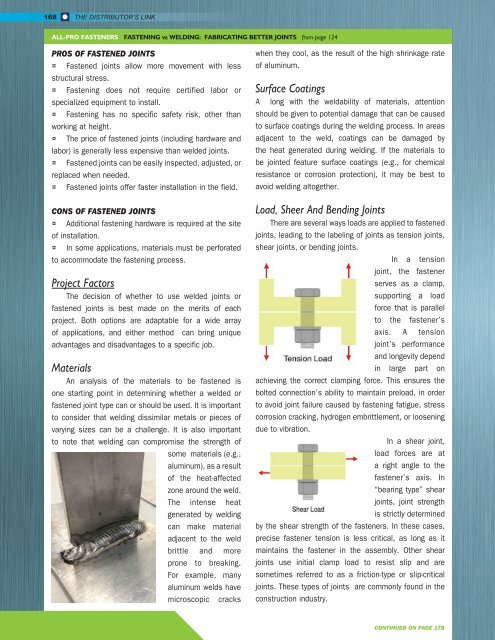FALL 2021
Distributor's Link Magazine Fall 2021 / Vol 44 No 4
Distributor's Link Magazine Fall 2021 / Vol 44 No 4
Create successful ePaper yourself
Turn your PDF publications into a flip-book with our unique Google optimized e-Paper software.
168<br />
THE DISTRIBUTOR’S LINK<br />
ALL-PRO FASTENERS FASTENING vs WELDING: FABRICATING BETTER JOINTS from page 124<br />
PROS OF FASTENED JOINTS<br />
¤ Fastened joints allow more movement with less<br />
structural stress.<br />
¤ Fastening does not require certified labor or<br />
specialized equipment to install.<br />
¤ Fastening has no specific safety risk, other than<br />
working at height.<br />
¤ The price of fastened joints (including hardware and<br />
labor) is generally less expensive than welded joints.<br />
¤ Fastened joints can be easily inspected, adjusted, or<br />
replaced when needed.<br />
¤ Fastened joints offer faster installation in the field.<br />
CONS OF FASTENED JOINTS<br />
¤ Additional fastening hardware is required at the site<br />
of installation.<br />
¤ In some applications, materials must be perforated<br />
to accommodate the fastening process.<br />
Project Factors<br />
The decision of whether to use welded joints or<br />
fastened joints is best made on the merits of each<br />
project. Both options are adaptable for a wide array<br />
of applications, and either method can bring unique<br />
advantages and disadvantages to a specific job.<br />
Materials<br />
An analysis of the materials to be fastened is<br />
one starting point in determining whether a welded or<br />
fastened joint type can or should be used. It is important<br />
to consider that welding dissimilar metals or pieces of<br />
varying sizes can be a challenge. It is also important<br />
to note that welding can compromise the strength of<br />
some materials (e.g.,<br />
aluminum), as a result<br />
of the heat-affected<br />
zone around the weld.<br />
The intense heat<br />
generated by welding<br />
can make material<br />
adjacent to the weld<br />
brittle and more<br />
prone to breaking.<br />
For example, many<br />
aluminum welds have<br />
microscopic cracks<br />
when they cool, as the result of the high shrinkage rate<br />
of aluminum.<br />
Surface Coatings<br />
A long with the weldability of materials, attention<br />
should be given to potential damage that can be caused<br />
to surface coatings during the welding process. In areas<br />
adjacent to the weld, coatings can be damaged by<br />
the heat generated during welding. If the materials to<br />
be jointed feature surface coatings (e.g., for chemical<br />
resistance or corrosion protection), it may be best to<br />
avoid welding altogether.<br />
Load, Sheer And Bending Joints<br />
There are several ways loads are applied to fastened<br />
joints, leading to the labeling of joints as tension joints,<br />
shear joints, or bending joints.<br />
In a tension<br />
joint, the fastener<br />
serves as a clamp,<br />
supporting a load<br />
force that is parallel<br />
to the fastener’s<br />
axis. A tension<br />
joint’s performance<br />
and longevity depend<br />
in large part on<br />
achieving the correct clamping force. This ensures the<br />
bolted connection’s ability to maintain preload, in order<br />
to avoid joint failure caused by fastening fatigue, stress<br />
corrosion cracking, hydrogen embrittlement, or loosening<br />
due to vibration.<br />
In a shear joint,<br />
load forces are at<br />
a right angle to the<br />
fastener’s axis. In<br />
“bearing type” shear<br />
joints, joint strength<br />
is strictly determined<br />
by the shear strength of the fasteners. In these cases,<br />
precise fastener tension is less critical, as long as it<br />
maintains the fastener in the assembly. Other shear<br />
joints use initial clamp load to resist slip and are<br />
sometimes referred to as a friction-type or slip-critical<br />
joints. These types of joints are commonly found in the<br />
construction industry.<br />
CONTINUED ON PAGE 178
















